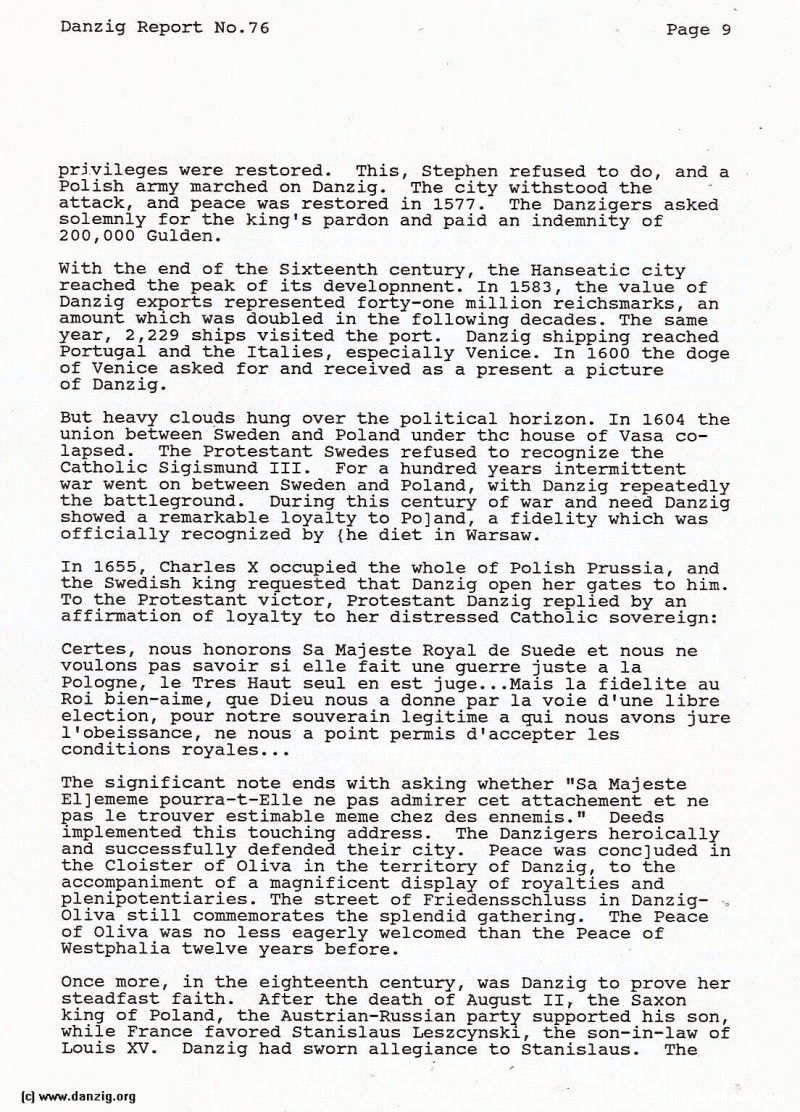
prvileges were restored. This, Stephen refused to do, and a Polish army marched on Danzig. The city withstood the attack, and peace was restored in 1577. The Danzigers asked solemnly for the king’s pardon and paid an indemnity of 200,000 Gulden.
With the end of the Sixteenth century, the Hanseatic city reached the peak of its developnnent. In 1583, the value of Danzig exports represented forty—one million reichsmarks, an amount which was doubled in the following decades. The same year, 2,229 ships visited the port. Danzig shipping reached Portugal and the Italies, especially Venice. In 1600 the doge of Venice asked for and received as a present a picture of Danzig.
But heavy clouds hung over the political horizon. In 1604 the union between Sweden and Poland under the house of Vasa co— lapsed. The Protestant Swedes refused to recognize the Catholic Sigismund III. For a hundred years intermittent war went on between Sweden and Poland, with Danzig repeatedly the battleground. During this century of war and need Danzig showed a remarkable loyalty to Pojand, a fidelity which was officially recognized by (he diet in Warsaw.
In 1655, Charles X occupied the whole of Polish Prussia, and the Swedish king requested that Danzig open her gates to him. To the Protestant victor, Protestant Danzig replied by an affirmation of loyalty to her distressed Catholic sovereign:
Certes, nous honorons Sa Majeste Royal de Suede et nous ne voulons pas savoir Si elle fait une guerre juste a la Pologne, le Tres Haut seul en est juge...Mais la fidelite au Roi bien—aime, que Dieu rious a donne par la voie d’une libre election, pour notre souverain legitime a gui nous avoris jure l’obeissance, ne nous a point permis d’accepter les
conditions royales...
The significant note ends with asking whether “Sa Majeste E1)ememe pourra—t—Elle ne pas admirer cet attachement et ne pas le trouver estimable meme chez des ennemis.” Deeds implemented this touching address. The Danzigers heroically and successfully defended their city. Peace was conc)uded in the Cloister of Oliva in the territory of Danzig, to the accompaniment of a magnificent display of royalties and plenipotentiaries. The street of Friedensschluss in Danzig— - Oliva still commemorates the splendid gathering. The Peace of Oliva was no less eagerly welcomed than the Peace of Westphalia twelve years before.
Once more, in the eighteenth century, was Danzig to prove her steadfast faith. After the death of August II, the Saxon king of Poland, the Austrian-Russian party supported his son, while France favored Stanislaus Leszcynski, the son—in—law of Louis XV. Danzig had sworn allegiance to Stanislaus. The
Danzig Report Vol. 1 - Nr. 76 - July - August - September - 1992, Page 9.
Hits: 3325
Added: 02/07/2015
Copyright: 2025 Danzig.org

